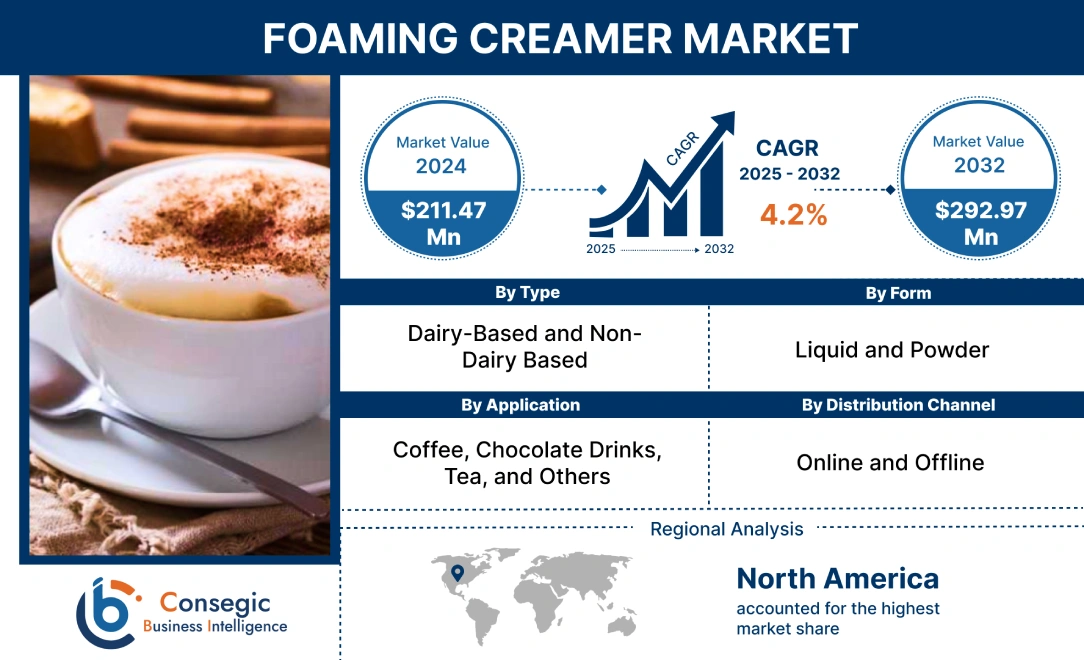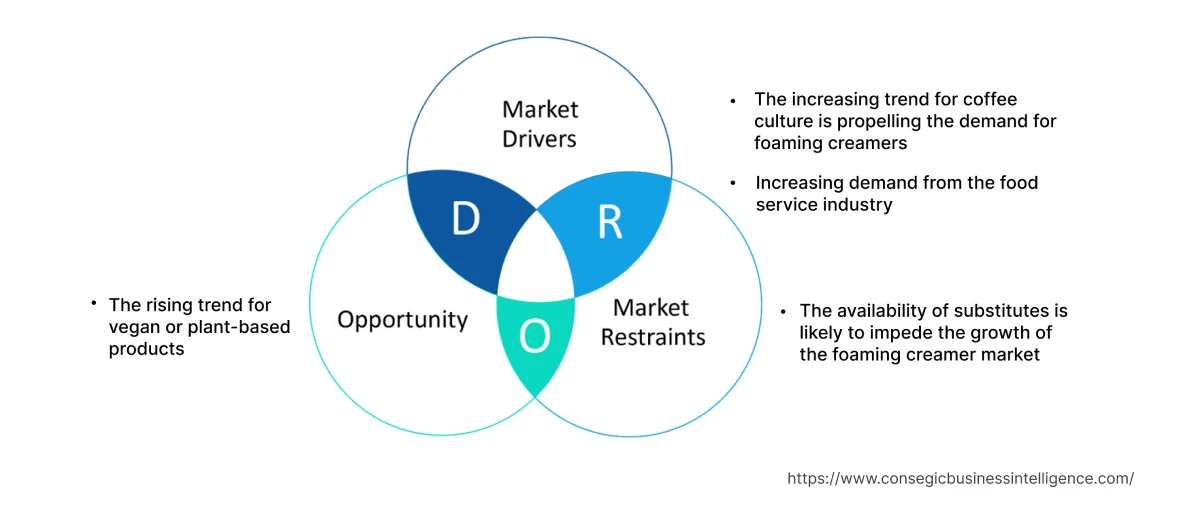Foaming Creamer Market Introduction :
Consegic Business Intelligence analyzes that the Foaming Creamer Market size is estimated to reach over USD 292.97 Million by 2032 from a value of USD 211.47 Million in 2024 and is projected to grow by USD 216.5 Million in 2025, growing at a CAGR of 4.2 % from 2025 to 2032.
Foaming Creamer Market Definition & Overview :
Foaming creamer is a type of powdered or liquid substance particularly used as a coffee or tea additive to create a creamy and foamy texture. It is used as a non-dairy alternative to traditional dairy creamers. It contains a combination of ingredients including vegetable fats, sweeteners, stabilizers, and emulsifiers. Its purpose of is used to enhance the texture and appearance of hot beverages such as coffee and tea. It is commercialized in the market based on different flavors such as vanilla, hazelnut, caramel, chocolate, and others. They are available in different formulations including regular or low-fat options catering to different dietary preferences.
Foaming creamer is commercialized in the market based on different flavors such as vanilla, hazelnut, caramel, chocolate, and others. They are available in different formulations including regular or low-fat options catering to different dietary preferences.
Foaming Creamer Market Insights :
Foaming Creamer Market Dynamics - (DRO) :
Key Drivers :
The increasing trend for coffee culture increases market trends.
Foaming creamer offers a way to enhance the taste and visual appeal of coffee beverages, making them more appealing to coffee enthusiasts. Analysis of foaming creamer market trends concludes that the emerging desire for premium coffee, coupled with an increasing demand for specialty coffee is driving the expansion of the market.
For instance, according to the data published by the National Coffee Association of the U.S.A. in March 2022, approximately 66% of Americans drink coffee each day, more than any other beverage including tap water. Hence, this increasing coffee culture is boosting the foaming creamer market demand.
Increasing demand from the food service industry leads to market growth
Foaming creamers are widely used by the food service industry to create attractive and consistent foam toppings on beverages to meet customer expectations and enhance their offerings. Analysis of trends of the market concludes that the food service sector particularly cafes, restaurants, quick service chains, and coffee shops are crucial for the growth of the market. Such types of establishments serve a variety of hot beverages and creamer is commonly used to provide frothy and visually appealing foam toppings to the beverages.
For instance, according to the statistics published by India Brand Equity Foundation, the quick-service restaurant (QSR) chains in India are expected to grow eightfold to USD 5.6 billion by 2020 from USD 720 million in 2011 at a growth rate of 27%. Hence, the growing food-service industries are propelling the foaming creamer market demand.
Key Restraints :
The availability of substitutes impacts market opportunities.
Diary-based foaming creamers, particularly those made with artificial ingredients, additives, and preservatives are likely to lead to potential health effects such as heart disease, diabetes, and others. Analysis of market trends showcases that the consumers are increasingly seeking products with clean label claims and natural ingredients such as flavored syrups, whipped cream, or natural sweeteners. Thus, the availability of these alternatives is hampering the growth of the foaming cream market.
Future Opportunities :
The rising trend for vegan or plant-based products gave rise to new opportunities
Consumers are shifting towards non-diary alternatives such as vegan or plant-based products for various reasons such as lactose intolerance, dietary restriction, and other ethical concerns. Further, traditional creamers have high saturated fat leading to an increased risk of high cholesterol. Hence, this increasing trend of veganism or plant-based products due to various health-related concerns is providing a lucrative opportunity to the key players for the development of plant-based creamers.
For instance, in March 2023, THIS PKN, a dairy-free brand owned by sustainable foods company Livestock, announced the launch of a new generation of plant-based creamers made from pecan milk. This plant-based creamer offers omega-3s, antioxidants, calcium, and zinc as well as vitamins A, B, and E.
Hence, the rising trend for vegan and plant-based products is emerging as one of many foaming creamer market opportunities.
Foaming Creamer Market Report Insights :
| Report Attributes | Report Details |
| Study Timeline | 2019-2032 |
| Market Size in 2032 | USD 292.97 Million |
| CAGR (2025-2032) | 4.2% |
| Based on the Type | Dairy-Based and Non-Dairy Based |
| Based on the Form | Liquid and Powder |
| Based on the Application | Coffee, Chocolate Drinks, Tea, and Others |
| Based on the Distribution Channel | Online and Offline |
| Based on the Region | North America, Europe, Asia Pacific, Latin America, and Middle East & Africa |
| Key Players | FrieslandCampina Kievit (Royal FrieslandCampina), Kerry, Mokate Sp. z o.o., MEGGLE GmbH & Co. KG, Santho Holland Food BV, Custom Food Group, PT Lautan Natural Krimerindo, Food Excellence Specialist Sdn. Bhd., PT Santos Premium Krimer, and Nestle |
Foaming Creamer Market Segmental Analysis :
Based on the Type :
The type segment is categorized into dairy-based and non-dairy-based. The largest foaming creamer market share for type segment is accounted to dairy-based segment in year 2024 owing to its creamy and rich taste. Dairy-based creamers have been used as a traditional creamers in a wide range of applications. The natural sweetness and diverse flavors of diary-based creamer enhance the overall taste and visual appearance of the beverages which are the crucial characteristics significantly boosting the foaming creamer market growth.
However, the non-dairy based segment is expected to grow at the fastest CAGR in the market during the forecast period owing to the increasing demand for plant-based alternatives and vegan options. Non-dairy-based creamers are plant-based alternatives as they are composed of ingredients such as almond milk, oat milk, or coconut milk.
Consumers who are lactose intolerant and have dietary allergies are seeking alternatives to traditional dairy creamers such as non-dairy creams which provides a suitable solution to meet their dietary preferences, in turn, driving the segmen's expansion.
For instance, in August 2022, Coffee Mate, a brand of Nestle introduced the launch of plant-based creamers in the flavors of French vanilla and caramel. Hence, the increasing varieties and flavors of non-dairy based creamers are anticipated to boost the expansion of the market.
Based on the Form :
The form segment is classified into liquid and powder. In 2024, the powder segment accounted for the highest market share in the market as they offer convenience in terms of storage, transportation, and usage. Further, the powder form provides longer shelf life as compared to liquid which is a key driver of the market.
The foaming creamer market analysis indicated that the liquid segment is anticipated to grow at the fastest CAGR over the forecast period. Liquid creamer helps to eliminate the need for dissolving powdered creamers and is directly added to the beverages. This makes them a convenient option for consumers seeking a quick and hassle-free solution for achieving a frothy texture which is a significant factor anticipated to prominently contribute to the foaming creamer market growth.
Based on the Application :
The application segment is divided into coffee, chocolate drinks, tea, and others. In 2024, the coffee segment accounted for the highest market share of 22.10% in the market and is also expected to grow at the fastest CAGR over the forecast period. The opportunities for growth are due to the increasing preference of consumers for specialty coffees such as iced coffee, coffee with ice cream, and others offered by coffee chains. Analysis of trends in the market indicates that the evolving research and developments are expected to help market players adopt innovative ways of product creation to cater to the growing needs of various end-users
For instance, in July 2020, Nestle and Starbucks introduce the launch of non-dairy coffee creamers made from almond milk and oat milk as part of their coffee alliance's plan to expand into plant-based products. Hence, the development of varieties of coffee creams is the key factor driving the segment's proliferation.
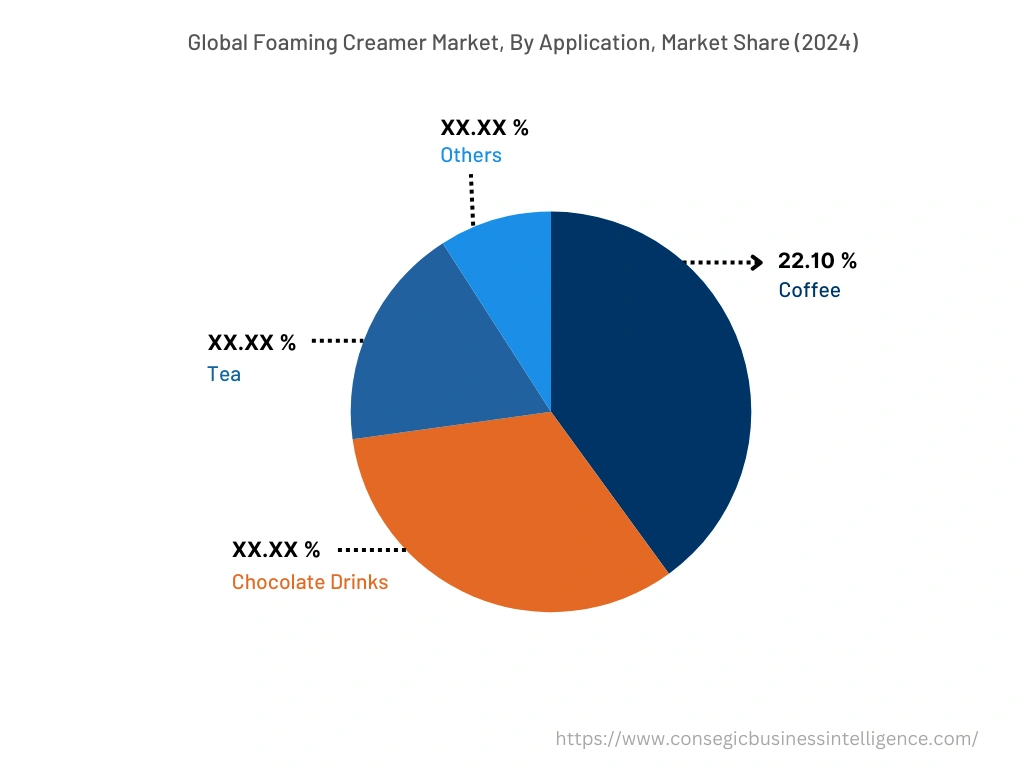
Based on the Distribution Channel :
The distribution channel is classified into online and offline. In 2024, the offline segment accounted for the highest foaming creamer market share as such creamers are available in a wide range of stores including hypermarkets and supermarkets, specialty stores, and others. Offline stores provide the opportunity to understand product ingredients and properties, resulting in the development of this segment.
The foaming creamer market analysis suggested that the online segment is anticipated to grow at the fastest CAGR over the forecast period. The rise of this segment is attributed to the shift in customer behavior of shopping online through e-commerce websites, online marketplaces, and mobile applications. Furthermore, the facility of home delivery provided by online sales channels is contributing to the expansion of the market.
For instance, according to India Brand Equity Foundation, the e-commerce market in India is expected to reach USD 111 billion by 2024 and is anticipated to increase to USD 200 billion by 2026. Hence, the rising trend of e-commerce is likely to boost the market development of foaming creamers.
Based on the Region :
The regional segment includes North America, Europe, Asia Pacific, the Middle East and Africa, and Latin America.
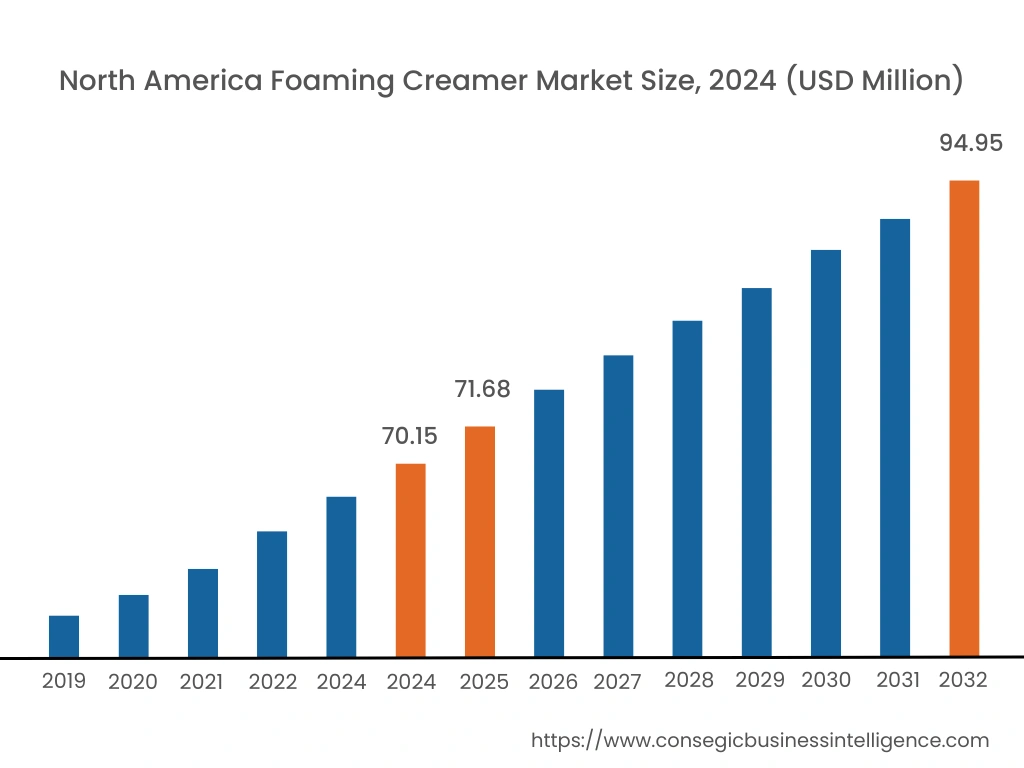
In 2024, North America accounted for the highest market share at 37.45% and was valued at USD 70.15 million, and is expected to reach USD 94.95 million in 2032. Analysis of foaming creamer market trends concludes that in North America, the U.S. accounted for the highest market share of 63.35% during the base year 2024. Owing to high consumption rates of coffee and coffee-based beverages. The region is the hub of coffee shops, cafes, and specialty coffee establishments that require foaming creamer to enhance the texture and appearance of coffee beverages.
Further, the key players in the region are focusing on expanding their product offerings through mergers, acquisitions, and partnerships. For instance, in September 2022, Toll House, a U.S.-based company partnered with Coffee-Mate, a brand of Nestle to launch a new limited-edition brown butter chocolate chip cookie-flavored creamer.
Hence, the development of varieties of foaming creamers is boosting the growth of the foaming creamers market in the region.
Asia Pacific accounted is anticipated to witness the fastest CAGR of 4.6% during the forecast period owing to the increasing expansion of the food service sector and rising adoption of Western coffee culture in 2032. The growth of the market is attributed to the rapidly growing industry sectors including food and beverage and hospitality. The sectors have extensive printing requirements for making vaious drinks and food items, driving the need for creamers. In addition, Asia Pacific has several leading creamer manufacturers that have a strong focus on research and development, leading to the development of better products.
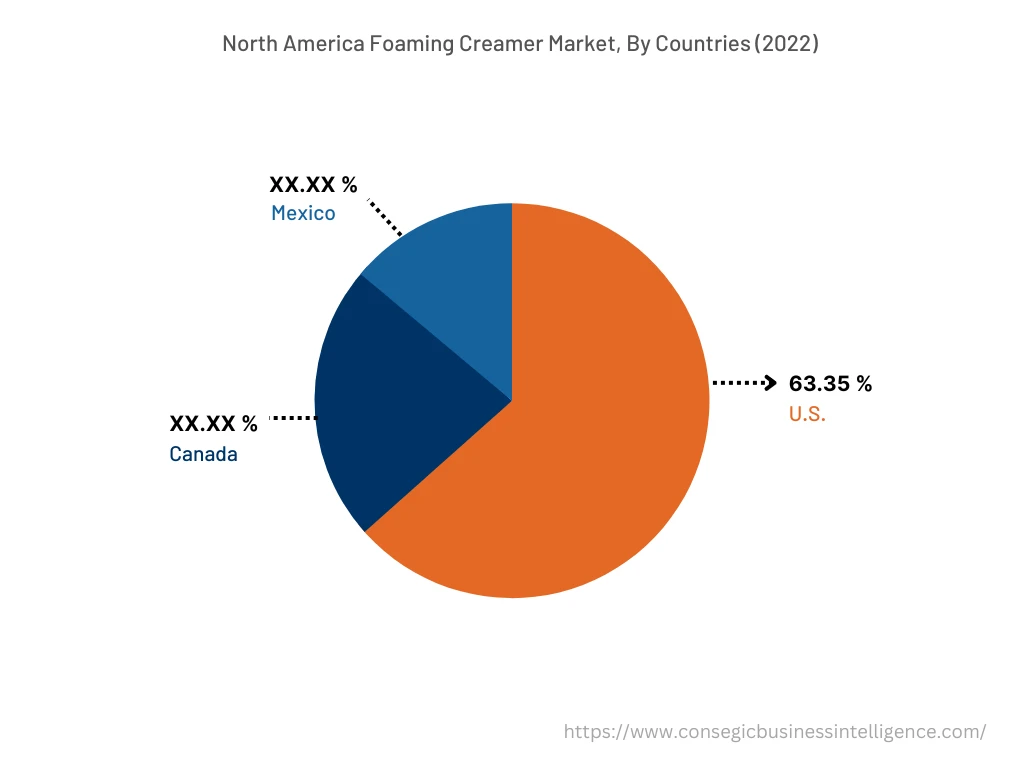
Top Key Players & Market Share Insights :
The foaming creamer market is highly competitive, with several large players and numerous small and mid-range enterprises. companies operating in foaming creamer industry have strong research and development capabilities and a strong presence in the market through their extensive product portfolios and distribution networks. The market is characterized by intense competition, with companies focusing on expanding their product offerings and increasing their product revenue through mergers, acquisitions, and partnerships. The key players in the market include-
- FrieslandCampina Kievit (Royal FrieslandCampina)
- Kerry
- Food Excellence Specialist Sdn. Bhd.
- PT Santos Premium Krimer
- Nestle
- Mokate Sp. z o.o.
- MEGGLE GmbH & Co. KG
- Santho Holland Food BV
- Custom Food Group
- PT Lautan Natural Krimerindo
Recent Industry Developments :
- In March 2022, Nestle announced the plan to invest USD 675 million to build a plant to produce beverages including oat milk coffee creamers aimed at fulfilling consumer demand for plant-based products
- In January 2024, Darigold, Inc launched dairy-based creamer under the Belle brand which are made with five simple ingredients and real cream. It aims to deliver unique taste to consumers.
- In December 2024, International Delight launched Cold Foam Creamer in three flavours namely "French Vanilla, Caramel Macchiato and Sweet & Creamy". It foams and creams a coffee without nay tools.
Key Questions Answered in the Report
What was the market size of the foaming creamer market in 2024? +
In 2024, the market size of foaming creamer was USD 211.47 million.
What will be the potential market valuation for the foaming creamer market by 2032? +
In 2032, the market size of foaming creamer will be expected to reach USD 292.97 million.
What are the key factors driving the growth of the foaming creamer market? +
The increasing trend for coffee culture and rising demand from the food service industry are the key factors driving the growth of the foaming creamer market.
What is the dominating segment in the foaming creamer market, by application? +
In 2024, the coffee segment accounted for the highest market share of 22.10% in the overall foaming creamer market.
Based on current market trends and future predictions, which geographical region will have the fastest impact on the foaming creamer market's growth in the coming years? +
Asia Pacific is expected to be the fastest-growing region in the market during the forecast period.
